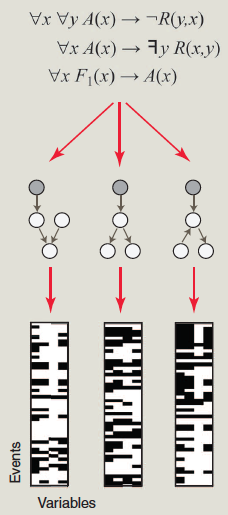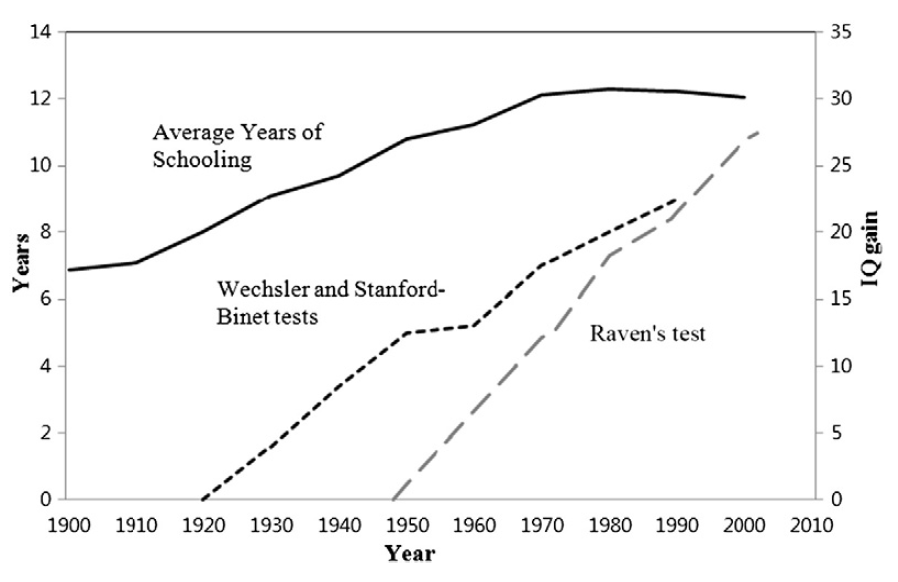























Modes of reasoning —
(given) Chimps are susceptible to the disease blicketitis.
(given) Squirrels are susceptible to the disease blicketitis.
————
(true or false?) Horses are susceptible to the disease blicketitis.

(true or false?) Horses are susceptible to the disease blicketitis.
(given) Chimps are susceptible to the disease blicketitis.
(given) Squirrels are susceptible to the disease blicketitis.
Below: the assumed representation of the structure of similarities among animals, based on similarity judgments made by subjects in a separate norming study. Right: correlations between the behavior of the Bayesian model and of the human subjects, in three versions of the induction task (n indicates the number of premise examples).


Children learning names for object concepts routinely make strong generalizations from just a few examples. The same processes of rapid generalization can be studied in adults learning names for novel objects created with computer graphics.
Here, given these alien objects and three examples (boxed in red) of "tufas" (a word in the alien language), which other objects are tufas? Almost everyone selects just the objects boxed in gray.
How to Grow a Mind: Statistics, Structure, and Abstraction, J. B. Tenenbaum et al., Science 331:1279 (2011).

d — the observed data;
h — the hypothesis in question;
H — the space of all possible hypotheses (which may be
intricately structured).

Learning names for categories can be modeled as Bayesian inference over a tree-structured domain representation. Objects are placed at the leaves of the tree; hypotheses about categories that words could label correspond to different nodes. Nodes at different depths pick out hypotheses at different levels of generality (e.g., Clydesdales, draft horses, horses, animals, or living things).
Priors [on category labels] favor higher-placed nodes and coherent categories.
Likelihoods [of images, given labels] assume that examples are drawn randomly from the node labeled by the word, favoring lower nodes that cover the examples tightly. (This captures the sense of suspicious coincidence: it would be very improbable — suspicious — for all examples of a word to cluster under the same lower branch of the tree if the word actually labels a high node.)
Posterior probabilities [of labels, given images] are computed by combining priors and likelihoods; the results favor generalizing across the lowest distinctive branch that spans all the observed examples (boxed in gray).

A search algorithm attempts to find both the form \(F\) (dictated by the abstract principles) and the structure \(S\) of that form that jointly maximize \(P(S,F\mid D)\), the posterior probability of the structure and form, given data \(D\). That posterior is a function of the product of \(P(D\mid S)\) and \(P(S\mid F)\).
In this example, the algorithm is given as data the features of animals; it then finds a tree structure with intuitively sensible categories at multiple scales.
[For examples of structures other than trees, see the next slide.]

A search algorithm attempts to find both the form \(F\) (dictated by the abstract principles) and the structure \(S\) of that form that jointly maximize \(P(S,F\mid D)\), the posterior probability of the structure and form, given data \(D\). That posterior is a function of the product of \(P(D\mid S)\) and \(P(S\mid F)\).
| problem setting | form | |
| (A) | animal species taxonomy | tree |
| (B) | SCOTUS conservative/liberal | chain |
| (C) | color similarity | ring |
| (D) | latitude/longitude | ring \(\times\) chain |
| (E) | morphed face images, 2 parameters | chain \(\times\) chain |

At the highest level are laws expressed in first-order logic
representing the abstract properties of causal relationships, the role of
exogenous interventions in defining the direction of causality, and
features that may mark an event as an exogenous intervention. These laws
place constraints on possible directed graphical models at the level
below, which in turn are used to explain patterns of observed events over
variables. Given observed events from several different causal systems,
each encoded in a distinct data matrix, and a hypothesis space of possible
laws at the highest level, the model converges quickly on a correct theory
of intervention-based causality and uses that theory to constrain
inferences about the specific causal networks underlying the different
systems at the level below.
A Hierarchical Bayesian model for learning an abstract theory of
causality.

"General
intelligence," objectively determined and measured,
C. Spearman, American Journal of Psychology 15:201-293 (1904).

Four examples of
Performance in such tests is tightly correlated: a subject who does well on one is likely to do well also on others.
The usual degree of correlation between scores in such tasks — about
0.75 — implies that about 50% of the
variance in subjects' performance is explained (through factor analysis) by positing the existence of
a common
"This so-called three-stratum model affords freedom from otiose arguments
about being 'for or against the general factor.'
The three-stratum account has been called a theory. It is not.
And it is not a model of the human cognitive architecture: rather, it is a taxonomy or model of test variances and co-variances. The taxonomy does not explain human intelligence differences, it describes them."
From the Scientific American article by L. Gottfredson
(1998):
... No matter their form or content, tests of mental skills invariably point to the existence of a global factor that permeates all aspects of cognition. And this factor seems to have considerable influence on a person's practical quality of life. Intelligence as measured by IQ tests is the single most effective predictor known of individual performance at school and on the job.
... The effects of environment on intelligence fade rather than grow with time.










"Turning to [NALS] Level 5, these two items require using tables of information. The
first one requires determining the cost of carpet for a room and the second
involves comparing the merits of two credit cards. Only 4% of white adults
in the United States routinely function at this level. If these tasks do
not seem difficult to the reader, it is because the reader is used to
operating at this cognitive level. Most people cannot."
The prime suspect behind gF:
The prime suspect behind gF:
"The realization that general intelligence and working memory might be closely linked brings together two concepts with massive psychometric evidence on the one hand and massive cognitive and neuroscience evidence on the other."

blue: intelligence tests (revealing gF)
green: tests of cognitive abilities (revealing WM)

This is the 3-back
Gray et al. (2003) used this task to demonstrate
that WM contributes to general intelligence to the extent that it can
support flexible,



Summary of behavioral + fMRI findings:

Respect the mouse!
"Recent studies are consistent with the presence of general intelligence in mammals (rodents and primates)."
 "In animals, intelligence is thought to involve an individual’s
ability to acquire new knowledge from interactions with the
physical or social environment, use this knowledge to organize
effective behavior in both familiar and novel contexts, and ENGAGE
WITH AND SOLVE NOVEL PROBLEMS."
"In animals, intelligence is thought to involve an individual’s
ability to acquire new knowledge from interactions with the
physical or social environment, use this knowledge to organize
effective behavior in both familiar and novel contexts, and ENGAGE
WITH AND SOLVE NOVEL PROBLEMS."
general problems
↓
general intelligence
IQ has traditionally been and is still being interpreted as measuring a person's fixed innate intellectual ability. In contrast, recent studies show that IQ strongly depends on formal schooling.
IQ and its equivalents have traditionally been and are still being used to justify discriminatory and unjust social policies.
Some of the relevant evidence concerning IQ and education:

Davis measured cognitive performance among Tsimané children between 8 and 18 years of age exposed to variable levels of formal schooling.
On the right: Scatterplot of performance on Raven’s Colored Progressive Matrices among children in consistently schooled, moderately schooled, and unschooled villages (N = 283). A dose-response effect is seen on Raven’s performance where, with more schooling, improved performance was also observed.

Results from path analysis among all students within schooled villages (N = 298). Standardized path coefficients listed for each related variable. Line thickness indicates significant negative path coefficients.

The phenomenon of rising IQ scores in high-income nations over the 20th century, known as the Flynn Effect, indicates historical increase in mental abilities related to planning, organization, working memory, integration of experience, spatial reasoning, unique problem-solving, and skills for goal-directed behaviors. [...] A field study with adults from insolated agrarian communities finds that variable exposure to schooling is associated with related variation in the mental abilities. [...] A historical analysis of the cognitive requirements of American mathematics curriculum finds a growing cognitive demand for birth cohorts from later in the 20th century. These findings show the impact of mass education on the Flynn Effect.

Structural equation model of association between Peruvian [adult] subjects' years of schooling and cognitive executive functioning.

The percentage of pages with reasoning, estimation, mental math, and self-check in the 1st and 4th grade textbooks combined, 1932–2000 [U.S.].
Intelligence test scores and educational duration are positively correlated. This correlation could be interpreted in two ways: Students with greater propensity for intelligence go on to complete more education, or a longer education increases intelligence.
We meta-analyzed three categories of quasi-experimental studies of educational effects on intelligence:
Across 142 effect sizes from 42 data sets involving over 600,000 participants, we found consistent evidence for beneficial effects of education on cognitive abilities of approximately 1 to 5 IQ points for an additional year of education.
Education appears to be the most consistent, robust, and durable method yet to be identified for raising intelligence.
Bowles, Samuel, Herbert Gintis, and Peter Meyer. Education, IQ, and the legitimation of the social division of labor, Berkeley Journal of Sociology, 20:233-264 (1975-76).
"A major proposition of Marxian educational theory is that the educational system in advanced capitalist societies is a mechanism for the reproduction of the social division of labor. This paper deals with one aspect of the reproduction process: the legitimation of the division of labor and the process of assigning individuals to its various positions. We say that a social process is legitimated when individuals are sufficiently convinced of its inevitability, desirability, or justness that united class action towards the transformation of the process is rendered infeasible. Thus the apparent legitimacy of social relationships is one, but clearly not the only, basis of the fragmentation of class solidarity."
Felix Klaassen, How IQ-scores encourage racism (blog post, 20 July 2020).
"Intelligence is one of the most studied aspects of human cognition. However, it seems that IQ – the intelligence quotient – does not accurately represent intelligence. In fact, the way IQ is determined encourages racism, and the scientific community is not free from these biases."

Last modified: Tue Aug 11 2020 at 08:48:21 EDT